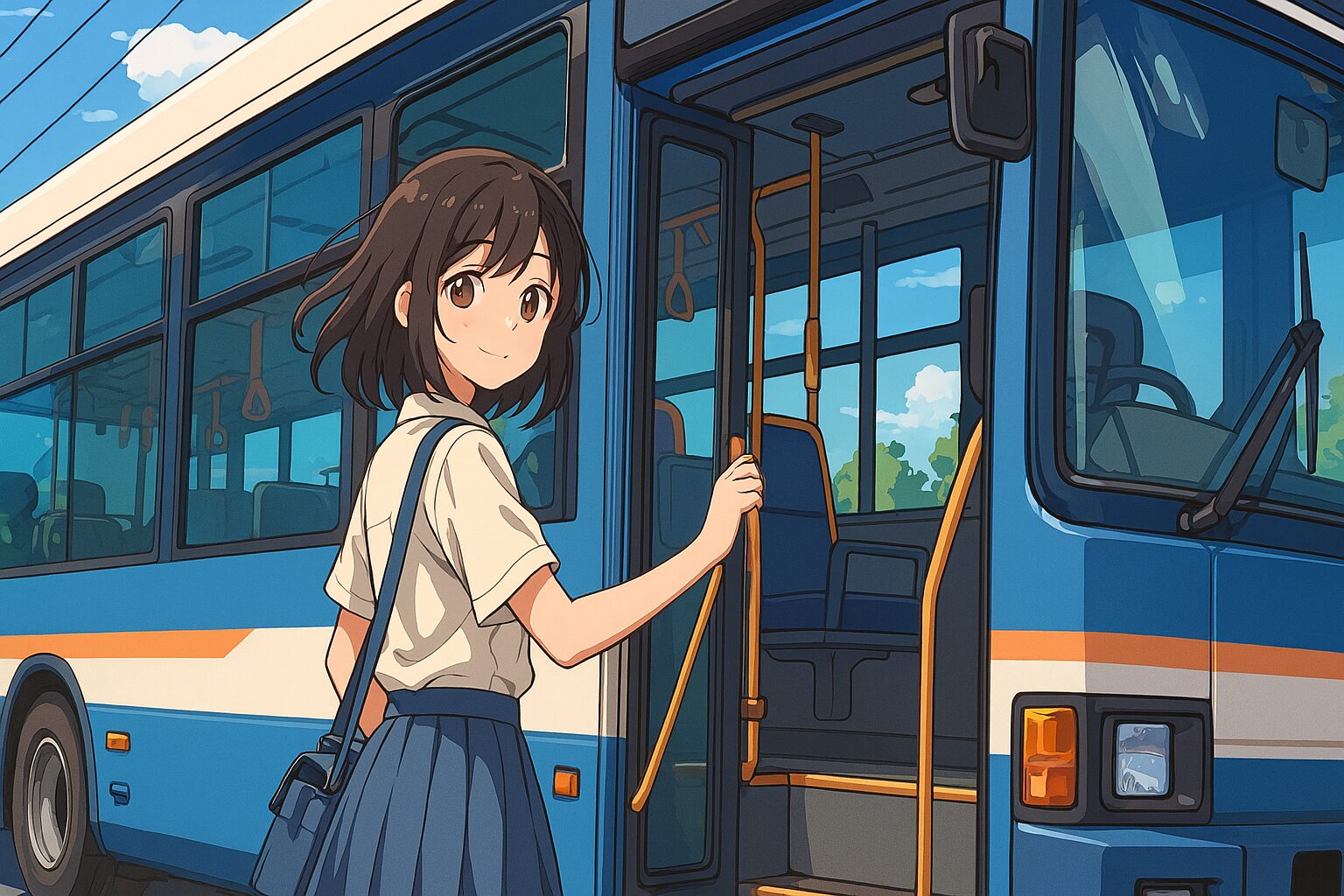Hello and welcome! Today we’re diving into Bus Day, celebrated every year on September 20 in Japan. Whether you’re new to Japanese culture or just curious, this article will guide you through the history, social role, and modern evolution of buses in Japan—one of the most essential yet overlooked parts of daily life.

- 🗓 What Is Bus Day?
- 🚐 Japan’s First Bus: A Steam-Powered Pioneer
- 🧑🤝🧑 The Social Role of Buses in Japan
- 🚌 Modern Bus Culture in Japan
- 🎉 Bus Day Events Across Japan
- 🌏 For International Visitors: Ride a Japanese Bus!
- 📚 Fun Bus Facts
- ✨ Final Thoughts: Bus Day Is About Connection
- 🔗 Related Links
- 🗓 バスの日ってなに?
- 🚐 日本初のバスはどんなものだった?
- 🧑🤝🧑 バスが果たす社会的役割
- 🚌 現代のバス事情:進化する日本のバス
- 🎉 バスの日のイベント
- 🌏 海外の読者へ:日本のバス文化を体験しよう
- 📚 バスにまつわる豆知識
- ✨ まとめ:バスの日は「人と街をつなぐ記念日」
- 🔗 関連リンク
🗓 What Is Bus Day?
Bus Day commemorates the first-ever bus service in Japan, which began on September 20, 1903. The day was officially established by the Japan Bus Association in 1987, and events are held nationwide to celebrate the occasion.
Learn more on the official website: Japan Bus Association – Bus Day
🚐 Japan’s First Bus: A Steam-Powered Pioneer
On that historic day in 1903, a company called Niino Shokai launched a six-seater steam-powered bus in Kyoto, running between Horikawa Nakadachiuri and Gion. The bus had no roof and looked nothing like today’s vehicles, but it marked the beginning of Japan’s public bus system.
For a deeper look into this story: MK Media – The Challenge and Setbacks of Bus Day
🧑🤝🧑 The Social Role of Buses in Japan
Buses are more than just transportation. In Japan, they connect urban centers, rural towns, and everything in between. They’re vital for commuting, school, shopping, and tourism. In many rural areas, buses are the only public transport available—lifelines for elderly residents and students.
Environmentally, buses help reduce traffic and carbon emissions by transporting dozens of passengers at once, making them a sustainable choice for cities and countryside alike.
🚌 Modern Bus Culture in Japan
- Tech-Enabled Travel: Most buses now support IC cards like Suica and ICOCA, offer GPS tracking, and display real-time arrival info.
- Tourist-Friendly Routes: From Mt. Fuji to Kyoto’s temples and Hokkaido’s nature trails, sightseeing buses offer curated travel experiences.
- Community Buses: Local buses serve neighborhoods with limited transit options, strengthening community ties and accessibility.
🎉 Bus Day Events Across Japan
Each year around September 20, cities host Bus Day events: bus exhibitions, ride-alongs, kids’ art contests, and even sales of retired bus parts. It’s a celebration for transit enthusiasts and families alike.
Check the latest event info here: Japan Bus Association – Event Info
🌏 For International Visitors: Ride a Japanese Bus!
If you’re planning a trip to Japan, don’t miss the chance to ride a local bus. It’s a great way to experience everyday life and explore areas beyond train lines:
- Kyoto City Bus: Ideal for temple-hopping and scenic routes through historic neighborhoods.
- Tokyo Metropolitan Bus: Covers everything from downtown skyscrapers to traditional shopping streets.
- Rural Buses: Slow-paced rides through countryside landscapes offer a peaceful, authentic travel experience.
📚 Fun Bus Facts
- Bus Girl Day (Feb 2): Marks the hiring of Japan’s first female bus conductors in 1920.
- Tour Bus Anniversary (Dec 15): Celebrates the launch of Japan’s first sightseeing bus in Tokyo.
- Dream Bus Day (June 10): Honors the start of the famous “Dream” highway bus service.
Reference: Wikipedia – Bus Day
✨ Final Thoughts: Bus Day Is About Connection
Bus Day isn’t just about vehicles—it’s about innovation, community, and the everyday journeys that shape our lives. Whether you’re a transit fan or a curious traveler, Japan’s bus culture offers a unique window into the country’s rhythm and resilience.
Next time you visit Japan, hop on a bus and discover the stories waiting beyond the train tracks.
🔗 Related Links
🚍 9月20日は「バスの日」:日本の公共交通の原点に触れる旅
こんにちは!今回は、9月20日に制定されている「バスの日」についてご紹介します。日本のことをあまり知らない海外の読者の方にも、わかりやすく、そして楽しく読んでいただけるように、歴史・文化・現代のバス事情まで幅広く掘り下げていきます。
🗓 バスの日ってなに?
「バスの日」は、1903年(明治36年)9月20日に日本で初めて営業バスが走ったことを記念して制定された記念日です。制定したのは公益社団法人日本バス協会で、1987年から毎年この日を「バスの日」として全国でイベントが開催されています。
詳しくは公式サイトをご覧ください:日本バス協会 バスの日
🚐 日本初のバスはどんなものだった?
1903年9月20日、京都市内の「堀川中立売〜七条〜祇園」間で、二井商会という会社が蒸気自動車を改造した6人乗りの乗合自動車を運行しました。屋根もなく、今のバスとはまったく違う姿でしたが、これが日本のバスの原点です。
詳しい歴史はこちらの記事が読み応えあります:MKメディア|バスの日の挑戦と挫折
🧑🤝🧑 バスが果たす社会的役割
バスは単なる移動手段ではありません。日本では、都市部から地方まで、通勤・通学・観光・買い物など、あらゆる場面で人々の生活を支えています。特に地方では、鉄道が通っていない地域の「命綱」として、バスが重要な役割を果たしています。
また、バスは環境にも優しい交通手段です。1台のバスが何十人もの乗客を運ぶことで、車の台数を減らし、CO₂排出量の削減にも貢献しています。
🚌 現代のバス事情:進化する日本のバス
- ハイテク化:ICカード対応、GPS運行管理、リアルタイム到着案内などが普及。
- 観光バスの魅力:富士山、京都、北海道などを巡る専用バスが人気。
- コミュニティバス:地域密着型で高齢者や子どもたちの移動を支援。
🎉 バスの日のイベント
毎年9月20日前後には、全国各地で「バスの日」関連イベントが開催されます。バス車両の展示、試乗会、子ども向けの絵画・作文コンクール、廃車部品の即売会など、バスファンにはたまらない内容です。
イベント情報は公式サイトでチェック:日本バス協会 イベント情報
🌏 海外の読者へ:日本のバス文化を体験しよう
もし日本に訪れる機会があれば、ぜひバスに乗ってみてください。以下のような体験ができます:
- 京都市バス:歴史ある街並みを走るバスで、寺社巡りに最適。
- 東京の都バス:下町から高層ビル街まで網羅する都市型バス。
- 地方のローカルバス:のんびりとした風景の中を走るバスで、旅の情緒を満喫。
📚 バスにまつわる豆知識
- バスガールの日(2月2日):日本初の女性車掌が採用された日。
- 観光バス記念日(12月15日):東京で初めて観光バスが運行された日。
- ドリーム号の日(6月10日):高速バス「ドリーム号」の運行開始記念日。
✨ まとめ:バスの日は「人と街をつなぐ記念日」
バスの日は、単なる交通の記念日ではありません。人々の挑戦、技術の進化、地域とのつながり、そして未来への可能性が詰まった日です。
日本のバス文化は、海外の方にとっても新鮮で魅力的な体験になるはず。ぜひ次回の旅では、バスに乗って「日本の日常」を感じてみてください。



コメント